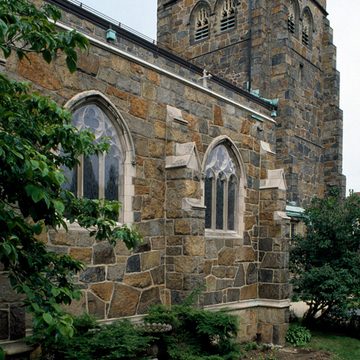Considered by scholars as his masterpiece, All Saints on Ashmont was the first church designed by Ralph Adams Cram. Cram's reinterpretation of Gothic played a major role in the revitalization of Gothic Revival church architecture in the early twentieth century. Constructed of granite with limestone trim, the widely publicized design for the Ashmont church was particularly admired for the carefully crafted simplicity of its plan—a wide nave covered by oak timber roof, flanked by arcaded aisles, and opening into a broad and richly decorated chancel. Johannes Kirchmayer carved over sixty sculptural figures and narrative scenes, and Charles Connick
Nearby Peabody Square was donated to the city in 1893 by Colonel Oliver Peabody and his wife, Mary, the principal donors of All Saints Episcopal Church; in 1911, a clock (LL) was added to the square, manufactured by the E. Howard Clark Company and designed by William D. Austin. Opposite the park Oliver Peabody built The Peabody (1896–1897, 197 Ashmont Street, NR), an architecturally distinguished early apartment house designed by Edwin J. Lewis. This Tudor Revival block became a planning and stylistic prototype of the streetcar suburb apartment house. Although not as generous in its allocation of open space as Cram's Richmond Court apartments (BR6; 1898) in Brookline, the Peabody also features a U-shaped courtyard plan. Spacious residential units included quarters for servants on the upper floors. The ground floor originally contained doctor's offices. On the south side of the Peabody, English-born architect W. Whitney Lewis designed 1911–1913 Dorchester Avenue (1884), a combination of shops and residential units constructed of brick, terra-cotta, and wood shingles.
East of All Saints Episcopal Church and Peabody Square extends a residential neighborhood with many architecturally distinguished late-nineteenth-century single-family houses. Largely developed by Herbert Carruth (for whom the principal street is named), the area features work by several Boston firms that specialized in suburban design, such as Edwin J. Lewis, W. Whitney Lewis, John A. Fox, William M. Bacon, and Allen and Kenway. Edwin J. Lewis's 1912 design for 240 Ashmont Street is a particularly fine example of Georgian Revival domestic architecture.


